

others
US Dollar jumps higher with risk off from Europe supporting Greenback flows – Crypto News
- The US Dollar trades slightly higher against major peers ahead of the US session.
- Fed’s Bowman delivers ultra hakwish comments.
- The US Dollar index trades in the green and pops back above 105.50.
The US Dollar (USD) resurfaces again and heads higher ahead of the US trading session with a risk-off mood, where Nvidia becoming the biggest worry for markets after being the golden boy for many weeks in a row. Meanwhile, in Europe, headaches emerge as well ahead of the French snap election’s first round on Sunday.
On the economic front, Tuesday’s calendar includes some housing numbers, the Chicago Fed National Activity Index, the Richmond Fed Manufacturing Index, and the US Conference Board Consumer Confidence as main elements. Additionally, two US Federal Reserve (Fed) members will take the stage and might comment on the current monetary policy stance. One element to highlight as well on the agenda is the first presidential debate on Thursday between current US President Joe Biden and former US President Donald Trump.
Daily digest market movers: US equities outperform against Europe
- At 12:30 GMT, the Chicago Fed National Activity Index for May will be released. The previous number was at -0.23, with no forecast available.
- At 13:00 GMT, the Housing Price Index for April will be released. An uptick of 0.3% is expected after rising by 0.1% in March.
- The Conference Board Consumer Confidence and the Richmond Fed Manufacturing Index for June will both be released at 14:00 GMT. Consumer Confidence is expected to ease to 100.00 after reaching 102.00 in May. The Richmond Manufacturing Index is expected to rise to 2 in June after the previous reading of 0.
- Two US Federal Reserve officials will make their way to the stage:
- At 11:00 GMT, Federal Reserve Governor Michelle Bowman delivered a speech about the US monetary policy and bank capital reform at the Policy Exchange UK event in London, United Kingdom. She remained very hawkish by saying hikes are still on the table if needed, and there are still too many risks for upside surprises in inflation.
- At 16:00 GMT, Federal Reserve Governor Lisa Cook delivers a speech about the US economic outlook in a luncheon at the Economic Club of New York.
- To round up the day, at 18:10 GMT, Bowman delivers pre-recorded opening remarks at the Midwest Cyber Workshop hosted by the Federal Reserve Bank of St. Louis, Chicago, and Kansas City.
- European equities are diving lower, with the major German Dax sinking over 1%. US futures are mildly in the green.
- The CME Fedwatch Tool is backing a rate cut in September, with odds now standing at 61.1% for a 25 basis point cut. A rate pause stands at a 32.3% chance, while a 50-basis-point rate cut has a slim 6.6% possibility.
- The US 10-year benchmark rate trades at 4.24%, rather steady since the end of last week. The spread between the French and German 10-years benchmark has fallen from 0.79% to 0.74% and is easing a touch, though still the highest level in over six years.
US Dollar Index Technical Analysis: Risk-off supports DXY
The US Dollar Index (DXY) is trading float on Tuesday, with some risk-off out of Europe supporting the Greenback. Expect not to see any big waves ahead of the US Opening Bell as markets are starting to struggle with how to price the possible outcome from the French snap elections on Sunday. Traders will also be looking for NVidia to see how it behaves and if it can end its recent correction.
On the upside, the first level to watch is 105.88, which triggered a rejection at the start of May and on Friday last week. Further up, the biggest challenge remains at 106.52, the year-to-date high from April 16. A rally to 107.20, a level not seen since 2023, would need to be driven by a surprise uptick in the US inflation or a sudden hawkish shift from the Fed.
On the downside, 105.52 is the first support ahead of a trifecta of Simple Moving Averages (SMA). First is the 55-day SMA at 105.23, safeguarding the 105.00 round figure. A touch lower, near 104.66 and 104.48, both the 100-day and the 200-day SMA form a double layer of protection to support any declines. Should this area be broken, look for 104.00 to salvage the situation.
Fed FAQs
Monetary policy in the US is shaped by the Federal Reserve (Fed). The Fed has two mandates: to achieve price stability and foster full employment. Its primary tool to achieve these goals is by adjusting interest rates. When prices are rising too quickly and inflation is above the Fed’s 2% target, it raises interest rates, increasing borrowing costs throughout the economy. This results in a stronger US Dollar (USD) as it makes the US a more attractive place for international investors to park their money. When inflation falls below 2% or the Unemployment Rate is too high, the Fed may lower interest rates to encourage borrowing, which weighs on the Greenback.
The Federal Reserve (Fed) holds eight policy meetings a year, where the Federal Open Market Committee (FOMC) assesses economic conditions and makes monetary policy decisions. The FOMC is attended by twelve Fed officials – the seven members of the Board of Governors, the president of the Federal Reserve Bank of New York, and four of the remaining eleven regional Reserve Bank presidents, who serve one-year terms on a rotating basis.
In extreme situations, the Federal Reserve may resort to a policy named Quantitative Easing (QE). QE is the process by which the Fed substantially increases the flow of credit in a stuck financial system. It is a non-standard policy measure used during crises or when inflation is extremely low. It was the Fed’s weapon of choice during the Great Financial Crisis in 2008. It involves the Fed printing more Dollars and using them to buy high grade bonds from financial institutions. QE usually weakens the US Dollar.
Quantitative tightening (QT) is the reverse process of QE, whereby the Federal Reserve stops buying bonds from financial institutions and does not reinvest the principal from the bonds it holds maturing, to purchase new bonds. It is usually positive for the value of the US Dollar.
-

 Cryptocurrency1 week ago
Cryptocurrency1 week agoWhale Sells $407K TRUMP, Loses $1.37M in Exit – Crypto News
-

 Blockchain1 week ago
Blockchain1 week agoRobinhood Dealing With Fallout of Tokenized Equities Offering – Crypto News
-

 Cryptocurrency1 week ago
Cryptocurrency1 week agoSatoshi-Era Bitcoin Whale Moves Another $2.42 Billion, What’s Happening? – Crypto News
-

 Blockchain6 days ago
Blockchain6 days agoRipple and Ctrl Alt Team to Support Real Estate Tokenization – Crypto News
-
Technology6 days ago
Fed Rate Cut Odds Surge As Powell’s Future Hangs In The Balance – Crypto News
-
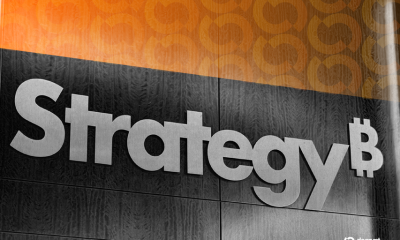
 Cryptocurrency1 week ago
Cryptocurrency1 week agoStrategy Resumes Bitcoin Buys, Boosting Holdings to Over $72 Billion in BTC – Crypto News
-

 Cryptocurrency1 week ago
Cryptocurrency1 week agoBitcoin Breaches $120K, Institutional FOMO Takes and House Debate Propel Gains – Crypto News
-
Technology6 days ago
Fed Rate Cut Odds Surge As Powell’s Future Hangs In The Balance – Crypto News
-
Business5 days ago
XLM Is More Bullish Than ETH, SOL, And XRP, Peter Brandt Declares – Crypto News
-
Cryptocurrency1 week ago
Why Is Bitcoin Up Today? – Crypto News
-
Business1 week ago
Pepe Coin Rich List June 2025: Who’s Holding Highest PEPE as it Nears Half a Million Holders? – Crypto News
-
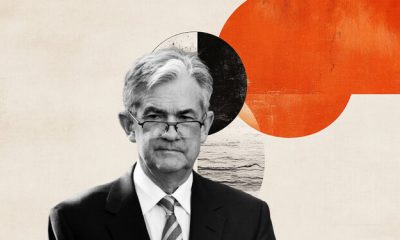
 others6 days ago
others6 days agoEUR/USD recovers with trade talks and Fed independence in focus – Crypto News
-
Business5 days ago
XRP Lawsuit Update: Ripple Paid $125M in Cash, Settlement Hinges on Appeal – Crypto News
-

 Cryptocurrency5 days ago
Cryptocurrency5 days agoBitcoin trades near $119K after new all-time high; Coinbase rebrands wallet to ‘Base App’ – Crypto News
-

 Blockchain1 week ago
Blockchain1 week agoZiglu Faces $2.7M Shortfall as Crypto Fintech Enters Special Administration – Crypto News
-

 Cryptocurrency1 week ago
Cryptocurrency1 week agoCardano’s $1.22 target: Why traders should be aware of THIS ADA setup – Crypto News
-

 Metaverse7 days ago
Metaverse7 days agoWhy voice is emerging as India’s next frontier for AI interaction – Crypto News
-

 Metaverse6 days ago
Metaverse6 days agoNvidia’s Jensen Huang says AI ‘fundamental like electricity’, praises Chinese models as ‘catalyst for global progress’ – Crypto News
-
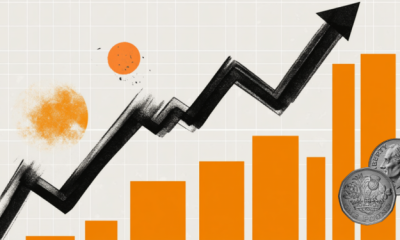
 others5 days ago
others5 days agoGBP/USD rallies on US PPI dip and Trump’s potential Powell removal – Crypto News
-

 others5 days ago
others5 days agoGBP/USD rallies on US PPI dip and Trump’s potential Powell removal – Crypto News
-

 Cryptocurrency1 week ago
Cryptocurrency1 week agoBitcoin and Ethereum ETFs record $3.6B inflows this week – Crypto News
-

 Technology1 week ago
Technology1 week agoAmazon Prime Day Sale 2025: Best earphones and headphone deals with up to 70% off – Crypto News
-

 Blockchain1 week ago
Blockchain1 week agoUK Banks Should not Issue Stablecoins – Crypto News
-

 Cryptocurrency1 week ago
Cryptocurrency1 week agoDonald Trump Jr. backs social media startup aiming to become a crypto powerhouse – Crypto News
-

 Technology1 week ago
Technology1 week agoGoogle, Anthropic, OpenAI and xAI join US defence to tackle national security with AI – Crypto News
-
Business1 week ago
CME XRP Futures Hit $1.6B In Total Trading Volume Since Launch – Crypto News
-
![Stellar [XLM] bulls exhausted after rally - Is a pullback nearby?](https://dripp.zone/news/wp-content/uploads/2025/07/Stellar-XLM-bulls-exhausted-after-rally-Is-a-pullback.webp-400x240.webp)
![Stellar [XLM] bulls exhausted after rally - Is a pullback nearby?](https://dripp.zone/news/wp-content/uploads/2025/07/Stellar-XLM-bulls-exhausted-after-rally-Is-a-pullback.webp-80x80.webp) Cryptocurrency1 week ago
Cryptocurrency1 week agoStellar [XLM] bulls exhausted after rally – Is a pullback nearby? – Crypto News
-
Cryptocurrency1 week ago
Fed’s Hammack Raises Inflation Concerns Amid Push For Interest Rate Cut – Crypto News
-

 Cryptocurrency7 days ago
Cryptocurrency7 days agoIt’s a Statement, Says Bitfinex Alpha – Crypto News
-

 Cryptocurrency6 days ago
Cryptocurrency6 days ago1inch price forecast: 1INCH hits 7-month high after double digit gains – Crypto News
-

 Cryptocurrency6 days ago
Cryptocurrency6 days ago1inch price forecast: 1INCH hits 7-month high after double digit gains – Crypto News
-
Business6 days ago
Ethereum Price Prediction- Bulls Target $3,700 As ETH Treasury Accumulation Soars – Crypto News
-

 others6 days ago
others6 days agoTop Crypto Exchange by Trading Volume Binance Announces Airdrop for New Ethereum (ETH) Ecosystem Altcoin – Crypto News
-

 others5 days ago
others5 days agoVanEck Details Key Drivers Boosting Bitcoin Price, Including Corporate Treasury Demand, ETF Flows and More – Crypto News
-
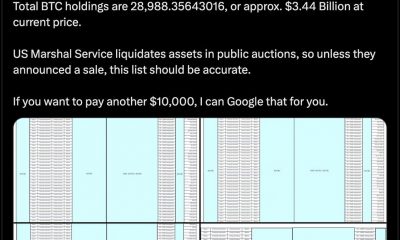
 De-fi5 days ago
De-fi5 days agoU.S. Marshals Peg Federal Bitcoin Holdings at 28,988 Tokens Worth $3.4 B – Crypto News
-
Cryptocurrency5 days ago
Russia’s $85 Billion Sberbank to Launch Crypto Custody Services – Crypto News
-

 Blockchain5 days ago
Blockchain5 days agoNasdaq Exchange Files SEC Form to List Staking Ethereum ETF – Crypto News
-

 Cryptocurrency4 days ago
Cryptocurrency4 days agoAnarchy, crime and stablecoins – Blockworks – Crypto News
-
Technology1 week ago
Peter Schiff Reignites Bitcoin Criticism, Calls 21M Supply Arbitrary – Crypto News
-
Business1 week ago
Ethereum ETFs Record Best Week Since Launch With $900M Inflows – Crypto News
-

 De-fi1 week ago
De-fi1 week agoOG Large-Cap Altcoins Lead Market Rally – Crypto News
-

 others1 week ago
others1 week agoJPMorgan Chase CEO Says Traders May Be Seriously Mistaken on Fed Rate Cuts: Report – Crypto News
-

 Cryptocurrency1 week ago
Cryptocurrency1 week agoFriday charts: The rise of zero-sum thinking – Crypto News
-

 others1 week ago
others1 week agoCrypto Hacker Who Drained $42,000,000 From GMX Goes White Hat, Returns Funds in Exchange for $5,000,000 Bounty – Crypto News
-

 Cryptocurrency1 week ago
Cryptocurrency1 week agoPump.fun Concludes $500M ICO in 12 Minutes — But Something Doesn’t Add Up – Crypto News
-

 Cryptocurrency1 week ago
Cryptocurrency1 week agoWhy Are So Many Crypto Games Shutting Down? Experts Weigh In – Crypto News
-

 De-fi1 week ago
De-fi1 week agoRobinhood Opens Ether and Solana Staking to US Users – Crypto News
-

 Cryptocurrency1 week ago
Cryptocurrency1 week agoTop 3 altcoins under $1 worth watching: Sei, Ethena, Arbitrum – Crypto News
-
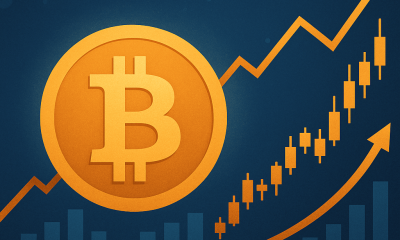
 Blockchain1 week ago
Blockchain1 week agoThe Bitcoin Liquidity Supercycle Has Just Begun: Hedge Fund CEO – Crypto News
-

 De-fi1 week ago
De-fi1 week agoRipple’s RLUSD Market Cap Passes $515M, Flips TrueUSD – Crypto News












